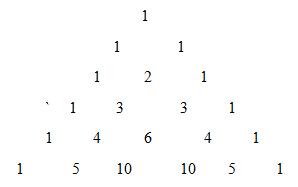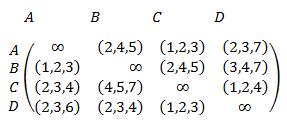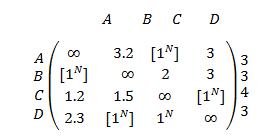Eurasian Journal of Analytical Chemistry
ISSN: 1306-3057 OPEN ACCESS 2019 14 (1): 84-90

Eurasian Journal of Analytical Chemistry
ISSN: 1306-3057 OPEN ACCESS 2019 14 (1): 84-90
Received: 25 December 2018 ▪ Revised: 15 January 2019 ▪ Accepted: 02 February 2019
Abstract: Travelling salesman problem is awell-known studied problem and intensely used in computational mathematics and management studies. In this paper we discuss a Neutrosophictriangular fuzzy numbers which are more realistic in nature. Neutrosophic triangular fuzzy numbers can converted to a Neutrosophic fuzzy numbers by using a Pascal’s graded mean approach and then the problem is solved by ones assignment method. Neutrosophic crisp travelling salesman problem also solved by using a score function and finally find the optimality. Numerical examples are included for a fruitful way
Keywords: Neutrosophic fuzzy number, Triangular Neutrosophic fuzzy number, Fuzzy travelling salesman algorithm, Graded mean approach, Score function.
The travelling salesman problem is the well-known problem and one of the most intensely studied problem in the field of computational mathematics. A huge number of techniques were constructed to solve the problem. The problem ascends from the characteristic situation of a salesman who wants to travel a cityonly once in a map and return to his home town. In such a way that the length of the journey is too short among all other possible journey. Fuzzy sets were proposed by Prof.Zadeh in 1965, to handle data and information feature of non-statistical ambiguity. One of the main applications of fuzzy arithmetic is accommodated the parameters and is represented by a fuzzy number.
The Neutrosophic set was first proposed by F.Smarandache in 1995. The evolution of Neutrosophic components are truth, indeterminacy and falsity membership values respectively and it is non-standard unit interval. Here, we generate two methods to solve the Neutrosophic travelling salesman problem. The Neutrosophictriangular fuzzy number using a graded mean approach. (i.e.,) all the Neutrosophictriangular fuzzy numbers can be converted to a Neutrosophic fuzzy number Neutrosophic crisp travelling salesman problem also discussed in this paper.
A fuzzy setcharacterized by a membership function mapping element of a domain, space, or the universe of discourse X to the unit interval [0,1] i.e. ���� = ������, �������� (���� )�/�������������.Here �������� (����): ���� → [0,1]is a mapping called the degree of membership function of the fuzzy set A and �������� (����)is called the membership value of ���� ∈ ���� in the fuzzy set A. These membership grades are often represented by real numbers ranging [0,1].
A fuzzy set A of real line R with membership function �������� (����): ���� → [0,1] is called fuzzy number if
(i) A is normal and convexity.
(ii) A must be bounded.
(iii) �������� (����) is piecewise continuous.
S. Subasri, Research Scholar, Department of Mathematics, Vels Institute of Science, Technology and Advanced Studies, Chennai, Tamilnadu. E-mail: subamyl@gmail.com
K. Selvakumari*, Professor, Department of Mathematics, Vels Institute of Science, Technology and Advanced Studies, Chennai, Tamilnadu. E-mail: selvafeb6@gmail.com
A fuzzy number ���� = (����0 , ����1 , ����2 ) is said to be triangular fuzzy number if its membership function is given by �������� (����)={

���� ����0 ����1 ����0 , ����0 ≤ ���� ≤ ����1 1, ���� = ����1 ����2 ���� ����2 ����1 , ����1 ≤ ���� ≤ ����2 0, ��������ℎ������������������������
Where ����0 ≤ ����1 ≤ ����2 are real numbers.
Let Xbe a universe. A Neutrosophic setA over X is defined by �������� = {〈����: ������������ (����), ������������ (����), ������������ (����)〉 ∶ ������������}where ������������ , ������������ , ������������ : ���� → ]0 , 3+ [are called the truth, indeterminacy and falsity membership function of the element ���� ∈ ����to the set �������� with 0 ≤ ������������ (����) + ������������ (����) + ������������ (����) ≤ 3+
Let X be the finite universe of discourse and �������� [0,1] denoted by the set of all triangular fuzzy numbers on [0,1]. A Neutrosophic triangular fuzzy set A in X is represented by �������� = {〈����: ������������ (����), ������������ (����), ������������ (����)〉 / ������������}
Where the Neutrosophic triangular fuzzy numbers, ������������ (����) = (��������1 ���� (����), ��������2 ���� (����), ��������3 ���� (����)), ������������ (����) = (��������1 ���� (����), ��������2 ���� (����), ��������3 ���� (����)), ������������ (����) = (��������1 ���� (����), ��������2 ���� (����), ��������3 ���� (����)) be the truth, indeterminacy and falsity membership degree of x in A and for every ���� ∈ ���� such that 0 ≤ ������������ (����) + ������������ (����) + ������������ (����) ≤ 3+
Suppose a salesman has to visits n cities. He visits one particularcity
return to the home town within a short period of time The Neutrosophicfuzzy travelling salesman problem in the following matrix may be formulated
Chen and Hrich [ ] proposed graded mean integration representation for representing generalized fuzzy number. This is useful to obtain the solution of the generalized fuzzy variables for travelling salesman problem. But this method is simply taken from the following pascal’s triangles. These are useful to take the co-efficients of fuzzy variables as pascal triangular numbers and we just add and divided by the total of pascal numbers.
The graded mean approach for triangular fuzzy number,
The Neutrosophic fuzzy travelling salesman problem can be taken as,
Step1: The Neutrosophic triangular fuzzy element can be converted to a Neutrosophic fuzzy numbers using graded mean approach for triangular fuzzy number
Step 2: In a minimization case, find the minimum element of each row in the distance matrix(say������������ ) and write it on the right side.
Then divide each element of ��������ℎ row of the matrix by ������������ . This will create atleast one ones in each row.
Step 3: Find the minimum element of each column in the distance matrix(say ������������ ) and write it below��������ℎ column. Then divide each element of��������ℎ column of the matrix by ������������ . This will create atleast a one in each column. Then make assignments in terms of ones.
Step 4:Obtain the optimum schedule and minimum cost for the travelling salesman problem.
Step 1: Construct the cost matrix of Neutrosophi fuzzy travelling salesman problem, �������� = (������������ )��������
Step 2: Determine the evaluation Neutrosophic matrix as �������� (����) = [(�������� )���� , (�������� )���� ] Where, [(�������� )���� , (�������� )���� ] = [ ������������ ((��������+�������� 2 ) , (1 ��������+�������� 2 )) , ������������ ((��������+�������� 2 ) , (1 ��������+�������� 2 )) ]



Step 3: Compute the score function �������� (����) of an alternative �������� (����) = 2[(�������� )���� (�������� )���� ]

i.e., �������� (����) = 2 [ ������������ ((��������+�������� 2 ) , (1 ��������+�������� 2 )) ������������ ((��������+�������� 2 ) , (1 ��������+�������� 2 )) ] , where 0 ≤ �������� (����) ≤ 1.
Step 4:Take the score function matrix as initial input data for Neutrosophic crisp travelling salesman problem and solve it by ones assignment method.

Method: 1-Solving Neutrosophic fuzzy travelling salesman problem Let us consider the following travelling salesman problem. A company has four territories. The working salesman has to distribute the products from one territory to other. The cost of the travel from territories A,B,C,D to A,B,C,D is given below
Solution
Step 1: To convert the given probleminto Neutrosophic number by using graded mean approach for triangular fuzzy number �������� (������������ ) MEMBERSHIP INDETERMINACY NON-MEMBERSHIP �������� (����12 ) 2 4 5 �������� (����13 ) 1 2 3 �������� (����14 ) 2 3 7 �������� (����21 ) 1 2 3 �������� (����23 ) 2 4 5 �������� (����24 ) 3 4 7 �������� (����31 ) 2 3 4 �������� (����32 ) 4 5 7 �������� (����34 ) 1 2 4 �������� (����41 ) 2 3 6 �������� (����42 ) 2 3 4 �������� (����43 ) 1 2 3
Step 2: The Neutrosophic fuzzy travelling salesman problem is given by,
Step 3:Find out the minimum Neutrosophic element of each row in the distance matrix(say������������ ) and put it on the right side of the matrix,


Then divide each element of ��������ℎ row of the matrix by ������������ Each row creates some ones and the matrix will reduce to the following
Step 4: Now find the minimum element of each column in distance matrix (say ������������ ) and divide each element of ��������ℎ column of the matrix by ������������ . This will create some ones to each row and column.
Step 5:The optimum schedule is given by
Step 6:Territory A assigns to Territory C Distance (1,2,3)
Territory B assigns to Territory A Distance (1,2,3)
Territory C assigns to Territory D Distance (1,2,4)
Territory D assigns to Territory B Distance (2,3,4) So, the root conditions are satisfied and is given by ���� → ���� ; ���� → ���� ; ���� → ���� ; ���� → ���� ���� → ���� → ���� → ���� → ���� The Neutrosophic fuzzy optimal solution =(1,2,3)+(1,2,4)+(2,3,4)+(1,2,3) =(5,9,14)





Method 2:Solving Neutrosophic crisp travelling salesman problem In Previous example, the Neutrosophic fuzzy travelling salesman problem is
The evaluation matrix is as follows:
The score function of the above matrix is


The resultant matrix is
Territory A assigns to Territory C Distance 3
Territory B assigns to Territory A Distance 3
Territory C assigns to Territory D Distance 4
Territory D assigns to Territory B Distance 5
Thus, the crisp optimum solution is ���� → ���� ; ���� → ���� ; ���� → ���� ; ���� → ���� ���� → ���� → ���� → ���� → ���� = ���� + ���� + ���� + ���� = ��������
In this paper, we proposed a new methodology to find the optimal solution for the Neutrosophic fuzzy travelling salesman problem by using the Pascal’s graded mean approach and alsocompared with crisp travelling salesman problem. This method is very useful for the future study. In future, we extend this method in generalized Neutrosophic fuzzy number.
[1] Kumar, A., & Gupta, A. (2012). Assignment and travelling salesman problems with coefficients as LR fuzzy parameters. International Journal of Applied Science and Engineering, 10(3), 155170.
[2] Atanassov, K.T. (1986). Intuitionistic fuzzy sets Fuzzy sets and systems, 20(1), 87-96
[3] Bellman, R. E., & Zadeh, L. A. (1970). Decision-making in a fuzzy environment. Management science, 17(4), 141-164.
[4] Deli, I., & Şubaş, Y. (2017). A ranking method of single valued neutrosophic numbers and its applications to multi-attribute decision making problems. International Journal of Machine Learning and Cybernetics, 8(4), 1309-1322.
[5] Jayanthi, V., & Anish, K.C. (2016). Solving transitive fuzzy travelling salesman problem using Yager’s ranking function International journal of engineering trends and technology, 39(6).
[6] Khadar, B., Rajesh, A B., Madhusudhan, R.K., Ramanaiah, M.V., & Karthikeyan, K. (2013). Statistical Optimization for Generalized Fuzzy number. International journal of Modern Engineering Research 3(2), 647-651
[7] Mukherjee, S., & Basu, K. (2011). Solving intuitionistic fuzzy assignment problem by using similarity measures and score functions. International journal of pure and Applied Sciences and Technology, 2(1), 1-18
[8] Broumi, S., Bakali, A., Talea, M., Smarandache, F., & Vladareanu, L. (2016) Shortest path problem under triangular fuzzy neutrosophic information. 10th International Conference on Software, Knowledge, Information Management & Applications (SKIMA), 169-174
[9] Smarandache, F. (2005). Neutrosophic set-a generalization of the intuitionistic fuzzy set. International journal of pure and applied mathematics, 24(3)
[10] Srinivasan, A., & Geetharamani, G. (2014). Proposed method for solving FTSP. International journal of application or innovation in engineering & management 3(4).
[11] Sahaya Sudha, A., Alice Angel, G., Elizabeth Priyanka, M., & Emily Jennifer, S. (2016). An Intuitionistic Fuzzy Approach for Solving Generalized Trapezoidal Travelling salesman problem. International journal of Mathematics Trends and Technology 29 (1).
[12] Kar, S., Basu, K., & Mukherjee, S. (2015). Application of neutrosophic set theory in generalized assignment problem. Neutrosophic Sets and Systems, 9, 75-79.
[13] Yahya Mohammed, S., & Divya, M. (2016). Solving fuzzy travelling salesman problem using octagon fuzzy numbers with α-cut and ranking technique. IOSR journal of mathematics, 12(6), 52-56.
[14] Zadeh, L.A. (1965). Fuzzy sets. Information and control, 8(3), 338-353.